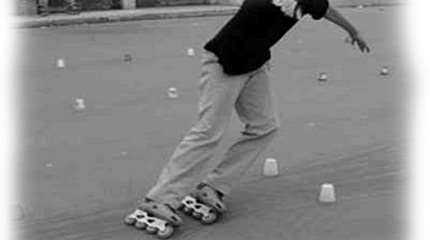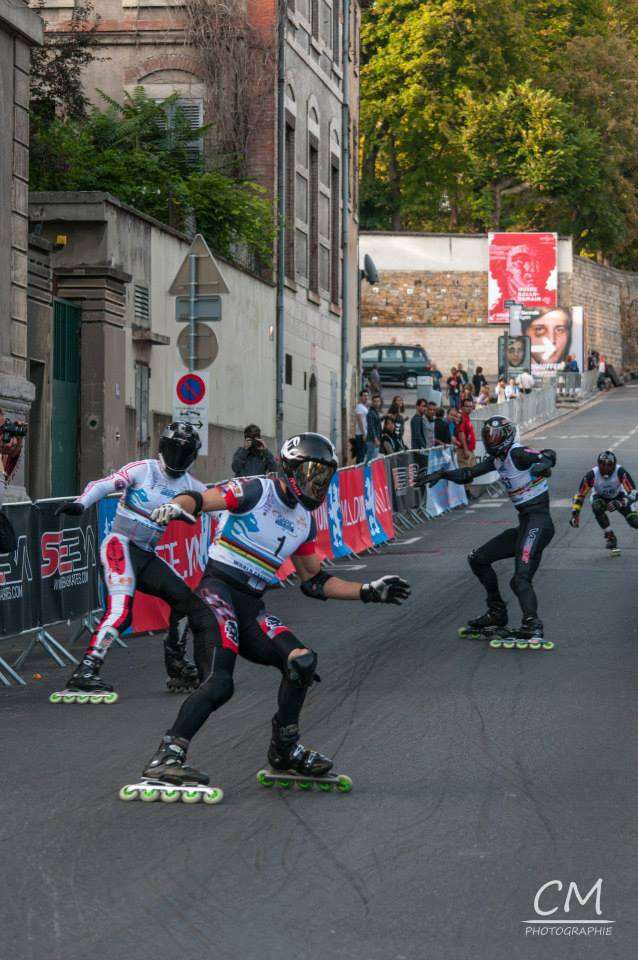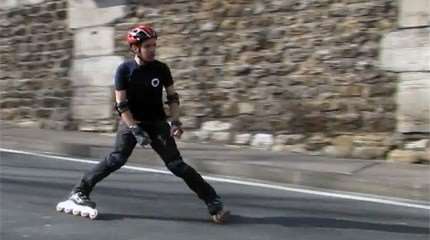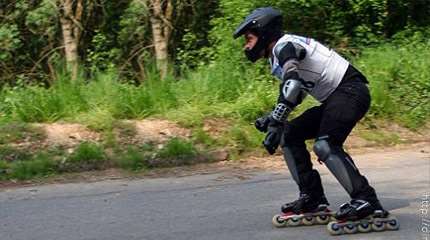Braking: Parallel sliding
Sliding is the most efficient as well as the most spectacular braking technique. Skaters manage to draw parallel lines covering several meters, and leaving a burnt smell. It is also the hardest braking technique to master...
Par Alexandre LEBRUN

The parallel slide: quite long to master
There are several types of sliding brakes with parallel feet.

The most common is the shifty flat, commonly called (parallel) slide by the skaters, but it can lead to confusion with bar sliding in aggressive skating.
What is a parallel slide?
It is simply a controlled skid on skates. The comparison is often made with skiing (even if it is less easy to slide on asphalt than on snow).
The other slides are mainly variations of the parallel slide.
It is an efficient technique but hard to handle.
Every playful skater dreams of mastering that technique. Indeed it is spectacular. And no doubt it is the most efficient one to brake at high speed on a short distance. No downhill skater worthy of the name can do without it.
What is the most suited equipment to learn how to brake in sliding?
The parallel slide can be done with any type of skates, even with big diameter wheels (100 mm and more).
However it is easier to succeed with:
- small wheels (84 mm and less)
- worn wheels
- hard wheels will skid more easily than soft wheels (which have more grip)
- rigid boots will give you better ankle support than soft boots
Tip
Start with smooth or wet surfaces, they tend to slip and it will be easier to skid. Don’t forget to wear protective pads at first!
Learning to slide with the bend technique
In order to do a bend, you should first know how to turn sharp. That video shows how a slide can be triggered due to the curve of a turn. Little by little, Luc Bourdin (the skater on the video) reduces the turning angle and brakes more and more sharply in bringing his feet closer and closer.
- Take a run-up and enough speed
- Turn on your good side
- Take the bend in leaning toward the inside of it
- You will feel that in emphasizing inclination angle, you will reach a limit where you lose grip
- The aim is to play with the limit:
– either in leaning enough for the wheels to skid
– or in doing a sharper, closer turn - Then you can try to line up your skates to skid
Tip
At first in order to lose grip, skaters often transfer their weight on their heels. Moreover, the higher the triggering speed, the straighter the slide. Downhill skaters have no trouble doing straight slides as soon as they have triggered them.
Watch out, the fact of sliding too straight may lead to uneven wheel wear. If the slide is perpendicular to the direction, the wheel won’t be able to turn during the slide and will wear only on one part, leading to what is called a “flat spot”.
Another efficient slide: the Magic (UFO) slide
 If you don’t feel the technique of the parallel slide, you can have a go at Magic (or UFO) sliding.
If you don’t feel the technique of the parallel slide, you can have a go at Magic (or UFO) sliding.
The principle is quite similar except that you put your legs into an X position during the slide (knees towards the inside just like on the picture, with feet wide apart tilting towards the inside on the inside edge of the wheels).
Most of the time, a Magic slide enables to brake harder than a classic slide because the angle between the wheels and the ground is shorter (in theory).
Placed as such, you gain is stability.
The steps of the Magic (UFO) slide
- Take a bit of speed in a gentle slope (15 to 20 kph seems to be a good basis on dry ground) in order to leave you time to place yourself.
- Put your body weight rather on your back foot.
- The most difficult part: place your favorite foot into a “soul” position (like a plow stop on one foot).
- Tilt your soul foot slightly towards the inside edge, in opposition to the trajectory, in order not to get hurt or thrown off. if it is too straight you are going to hurt yourself.
- Place your back foot just like for a T-stop, so that your body is parallel to the road.
- At that moment, both feet are parallel to each other.
- You can get lower with feet wide open and knees closed to gain in stability.
Evolution: sliding in lanes
Here is a game of which slalomers and free skaters are very fond: lane sliding!
- Get a dozen cones
- make a lane, about 1.5m wide, marked with 2×5 cones
- Start at a good distance and slide in the lane
- Gradually reduce the width of the lane as you master the spacing
The are two goals in that game:
- Doing the longest and straightest slide as possible
- Managing to slide in the narrowest space as possible
The best sliders manage to slide in lanes hardly wider than their skates!
Variation
For the gods of the slide: sliding in slaloming into a line of cones!
Useful links
cess-slide on wikimedia
Download the video “Pari Slide” in a good definition (xvid format)
Translation: Chloé Seyres
Photos : Rollerenligne.com
Videos: ReL, Fabien Caron, Luc Bourdin


